29.06.10: CERN opens new interactive visitor centre
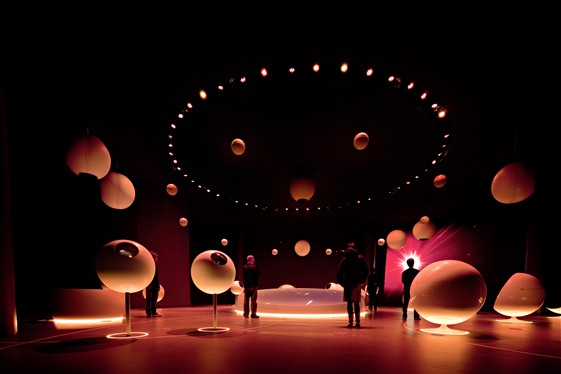
Inside CERN's new "Universe of Particles" exhibition PHOTO: M. Brice / CERN More photos »
Universe of Particles, an immersive interactive journey into the heart of matter, opens its doors to the public on 1 July 2010. CERN's new permanent exhibition is located in the iconic Globe of Science and Innovation building on the Meyrin site.
More information
21.06.10: CERN enthusiasts take part in solar-powered race
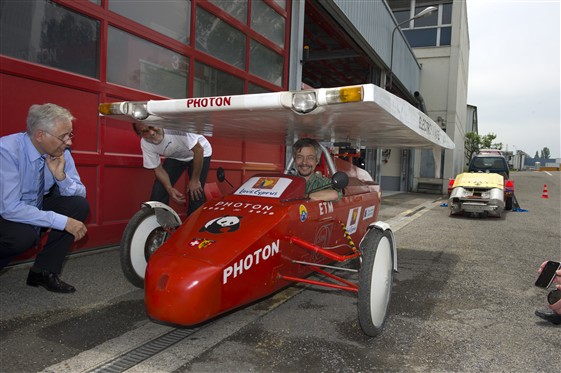
William van Sprolant in the CERN Solar Club's solar car Photon. The other crew members were Jean Donnier and Paulus Gelissen.
PHOTO: M. Brice / CERN More photos »
The CERN Solar Club has been a hub for renewable energy enthusiasts for over 25 years. On 19 June it took part in the Cyprus Institute's Solar Car Challenge in Cyprus with the latest incarnation of its solar-powered car, Photon.
"We started developing the first version of Photon in 1986", says Jean Donnier, one of its designers and a founding member of the Solar Club. Since then Photon has undergone four major upgrades, although the car retains many original parts including its aviation-grade aluminium body. Photon has already participated in races in Switzerland, Austria and France - winning the Paris EUROSOL competition in 1989.
Photon IV was the veteran car at the Cyprus Institute's challenge, and did admirably, clocking up the fastest lap time. "Many of the other crews in the challenge were younger than our Photon!" exclaimed a delighted Paulus Gelissen after the race.
More information
11.06.10: A big draw: physicists portrayed by children
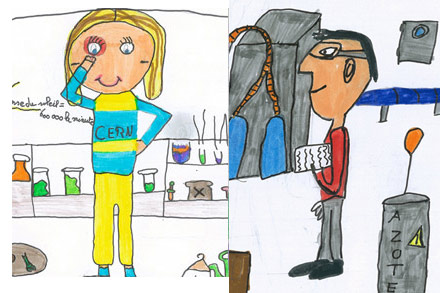
Two of the drawings of physicists produced by children involved in the "Dessine-moi un physicien" project run by CERN
Some 400 schoolchildren aged from 9 to 11 were asked to draw and describe a physicist, both before and after a visit to CERN. Twenty local primary school classes took part in this six-month project, leading to an exhibition of their drawings at CERN. The children's humourous and imaginative depictions of physicists offer a fresh insight into the world of physics research.
More information
07.06.10: Particle chameleon caught in the act of changing
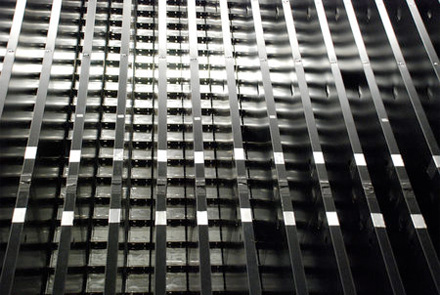
The OPERA detector in Gran Sasso is made up of walls of special bricks interwoven with plastic scintillator plates. IMAGE: OPERA experiment. More photos »
Researchers on the OPERA experiment at the INFN’s Gran Sasso laboratory in Italy announced on the 31 May the first direct observation of a tau particle in a muon neutrino beam sent through the Earth from CERN, 730 km away. This is a significant result, providing the final missing piece of a puzzle that has been challenging science since the 1960s, and giving tantalizing hints of new physics to come.
More information
12.05.10: MoEDAL becomes LHC's seventh experiment
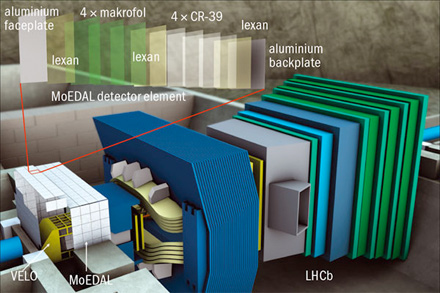
The MoEDAL experiement inside the LHCb VELO cavern. IMAGE: MoEDAL collaboration.
MoEDAL is the newest of the experiments that will investigate particle collisions at the Large Hadron Collider. Approved by the CERN Research Board in December, the MoEDAL experiment will search for very specific exotic particles.
The experiment is relatively small, cheap and quick to install but its physics potential is huge. The MoEDAL detector will consist of layers of plastic attached to the walls and ceiling of the cavern that houses the VELO detector of the LHCb experiment. Physicists will look for tell-tale collinear 'etch-pits' created by a stable particle such as a magnetic monopole or a massive stable supersymmetric particle crossing through the plastic.
The international MoEDAL collaboration, made up of physicists from Canada, CERN, the Czech Republic, Germany, Italy, Romania and the US, have already installed the first square metre of plastic in the LHCb cavern and are preparing to deploy the rest of the detector during the next planned long shutdown of the LHC, which will start late in 2011.
More information
- CERN Courier: MoEDAL becomes the LHC's magnificent seventh
- CERN Bulletin: The Magnificent Seventh
- For further information, including the Technical Design Report, see: http://web.me.com/jamespinfold/MoEDAL_site/Welcome.html
03.05.10: On the trail of dark matter
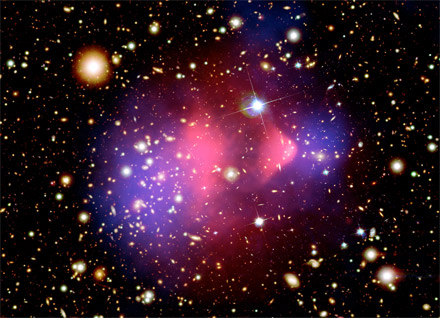
A composite image of the Bullet Cluster. Gravitational lensing reveals the extent of dark matter (shown in blue) beyond that of normal matter (hot gas, shown pink). IMAGE: X-ray: NASA / CXC / CfA / M.Markevitch, Optical and lensing map: NASA / STScI, Magellan / U.Arizona / D.Clowe, Lensing map: ESO WFI
The planets, stars and galaxies that we observe make up only 4% of the Universe. The rest is a mixture of matter that remains unseen - 'dark' matter (26%) - and dark energy (about 70%). The LHC experiments have the potential to discover new particles that could explain what dark matter is.
More information
21.04.10: Puzzling antimatter
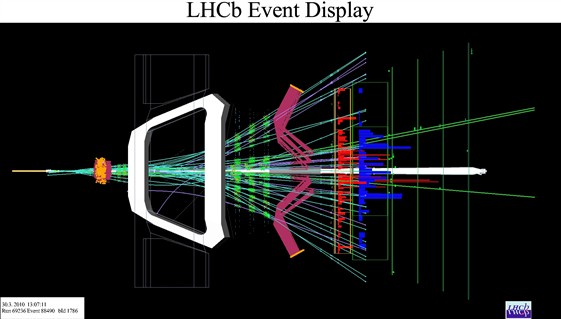
7 TeV collision event seen by the LHCb detector. The LHCb experiment at the LHC will be well placed to explore the mystery of antimatter.
For many years, the absence of antimatter in the Universe has tantalised particle physicists and cosmologists: while the Big Bang should have created equal amounts of matter and antimatter, we do not observe any primordial antimatter today. Where has it gone? The LHC experiments have the potential to unveil natural processes that could hold the key to solving this paradox.
More information
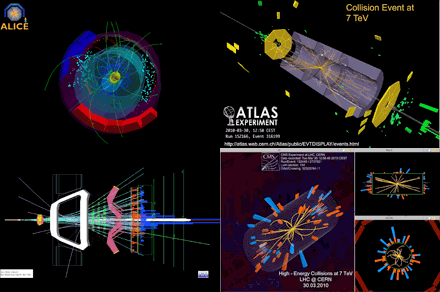
7 TeV collision events seen today by the LHC's four major experiments (clockwise from top-left: ALICE, ATLAS, CMS, LHCb). More LHC First Physics images »
LHC research programme gets underway
Geneva, 30 March 2010. Beams collided at 7 TeV in the LHC at 13:06 CEST, marking the start of the LHC research programme. Particle physicists around the world are looking forward to a potentially rich harvest of new physics as the LHC begins its first long run at an energy three and a half times higher than previously achieved at a particle accelerator. Read more...
![[IMAGE]](../features/1003_firstphysics.png)